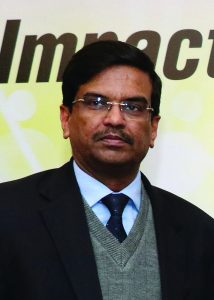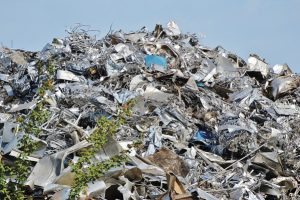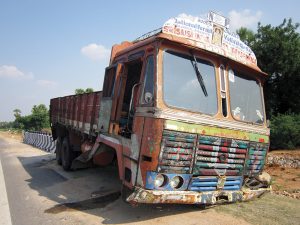
With the talk of scrappage policy, the End-Of-Life (ELV) journey of an automobile is once again under the spotlight.
Story by Deepti Thore
India is expected to reach a market size of 20 to 22 million ELVs by 2025 as per a report released by Kearney. This would amount to a business segment value between Rs.9400 crores and Rs.12,500 crores. With the scrappage policy expected to be announced soon, the generation of scrap through the ELV journey of automobiles is expected to reach 5.6 million tonnes per annum by 2025. Expected to have a major share of around 40 to 50 per cent are commercial vehicles(CVs) in terms of market value simply because the content that goes in them is considerably more per vehicle when compared to a typical passenger car or a two-wheeler. CVs are also said to emit more on a per vehicle basis when compared to a private vehicle. And, despite there being a lot more two-wheelers or three-wheelers as CVs often tend to stay on the road for more years on an average, emit more during their operating lifecycle and are perhaps more liable to flouting emission and other norms.

Putting CVs under the spotlight when compared to the private vehicles is their fairly significant contribution to the market size even though they amount to approximately six per cent of the vehicle parc, according to the analysis made by Kearney. Shovik Banerjee, Principal, Kearney informed that passenger vehicles acquire acquire the second-largest share of around 10 to 30 per cent with about 12 per cent vehicle parc followed by three-wheelers which are about five per cent in terms of value as well as in terms of the number of units, and then two-wheelers with a share of 25-35 per cent in ELVs and vehicle parc of about 80 per cent. The value of that particular segment in terms of end of life vehicles is about 25 to 35.
Understanding ELV
As per the forecast provided by the Feedback consultancy to estimate the number of ELVs in future, around 28 million vehicles will be ELVs by 2030. These are vehicles produced from 2010 to 2015, the report said. While the number of vehicles reaching end-of-life is increasing exponentially with the help of world-class manufacturing and primitive scrapping systems, the urgent need is to evolve environmentally feasible, socially acceptable viable regimen of recycling of ELVs, expressed Captain N S Mohan Ram VSM, I.N (Retd.), FNAE. The ‘Environmentally Sound Management of ELVs in India’ virtual lecture organised by SIAM highlighted the sustained utilisation of resources to replace the traditional linear economy.
 Deliberating on the effect of the scrappage policy that is expected, and how it would influence a change at the OEM level, at the supplier level and various others including at the buyer and operator level, Shovik stated that ELV involves a journey that is challenging as well as rewarding in terms of minimising wastage and the associated ecological implications. Providing an overview of the economics of recycling of ELV in India which could be built in-line with the global trends, the session saw Kaushik Madhavan, Vice President- Mobility Practice, Frost & Sullivan (F&S) stressing on the need of guidelines and standards to be set up for incorporation of 3R model (Restore, Reuse and Recycle) within the auto industry which could include recycling of batteries. He also pointed at the global scenario that involves sharing of responsibility by the stakeholders (including battery and vehicle manufacturers).
Deliberating on the effect of the scrappage policy that is expected, and how it would influence a change at the OEM level, at the supplier level and various others including at the buyer and operator level, Shovik stated that ELV involves a journey that is challenging as well as rewarding in terms of minimising wastage and the associated ecological implications. Providing an overview of the economics of recycling of ELV in India which could be built in-line with the global trends, the session saw Kaushik Madhavan, Vice President- Mobility Practice, Frost & Sullivan (F&S) stressing on the need of guidelines and standards to be set up for incorporation of 3R model (Restore, Reuse and Recycle) within the auto industry which could include recycling of batteries. He also pointed at the global scenario that involves sharing of responsibility by the stakeholders (including battery and vehicle manufacturers).
Of the opinion that the steady shift towards ELVs in India has multiple implications for all the stakeholders in particular and the economy at large, Rajesh Menon, Director General, SIAM averred that recycling of ELVs is meant to reduce the carbon footprint of the industry. Emphasising on the generation of a carbon trail by manufactured products that continues all the way to their end-of-life and subsequent disposal, Menon explained that it is imperative that environmentally-sound management policies and regulations are put in place in advance to ensure ELVs leave a low carbon trail throughout their life cycle.
Scrappage policy
Drawing attention to a recent announcement by Prakash Javadekar, Union Minister of Environment, Forest & Climate Change, Information & Broadcasting, and Heavy Industries & Public Enterprises, Government of India, that the scrappage policy is ready and will be rolled out soon,Shovik Banerjee mentioned that a lot of work has gone into formulating the policy. The aim, he said was to provide financial incentive to the vehicle owners to get them to scrap outdated models and replace them with newer vehicles. Kearney worked on the draft by involving analytical modelling, impact assessment, policy drafting, incentive restructuring and cabinet note drafting.
Stating that it was necessary to identify vehicle segments to focus upon from a pollution impact point of view, Shovik Banerjee said that attention ought to be on what replacement norms should go in, what is the requirement in terms of ELV policy, how to operationalise in terms of money, complimentary policy to meet the need for incentives to decentralise use of old vehicles and a final implementation plan. Aiming to reduce vehicular pollution by phasing out older, polluting vehicles, the scrappage policy is also engineered to drive the demand for the automotive segment through incentives to voluntarily replace them, remarked Shovik. An age-of-vehicle based mandatory scrapping will also be implemented as per the Motor Vehicle Act, he added. Stating that the policy, which has been in the works since 2016, would trigger the development of a structured scrapping ecosystem, Shovik expressed that an Authorised Vehicle Scrapping Facility (AVSF) programme would simplify the process of setting up scrapping facilities, guidelines for Environmentally Sound Facilities (ESF) for handling, processing and recycling ELVs.
Scrap recycling value chain
Stressing on revised guidelines issued last year to create uniform structured guidelines for environment-friendly scrapping and other policies or guidelines for plastic waste, battery waste, e-waste, steel scrap recycling and stronger inspection and certification mechanism, Shovik averred that this would help stimulate the setting up of an organised vehicle scrappage industry. Explaining that the scrap recycling value chain has three key elements — collection and aggregation, dismantling and processing, and sales and consumption, Shovik expressed that various entities disposing vehicles would include bulk disposers like automotive manufacturers, public transport units, large fleet owners, small-medium disposers like taxi operators or small fleet owners and individual disposers like individual vehicle owners. There would also be vehicles which are abandoned by the roadside, he added. Beyond this, informed Shovik, there could be other channels too. Channels like various auction routes, various automotive dealerships as well as auto workshops.
 Drawing attention to the Kearney report, Shovik Banerjee in his presentation pointed out that there are six major auto collection hubs in India with the Delhi NCR region having the biggest facility. This facility currently accounts for 35 per cent share of the total vehicles scrapped in the country, he added. In the case of dismantling and processing, Shovik stated that it is currently highly fragmented. Reshaping it into an organised trade is a big opportunity that could be tapped, he added. Informing that most cities have vehicle dismantling hubs, Shovik averred that an organised trade would mean the following of scientific ways to de-pollute and dismantle. De-pollution, he said, involves removal of hazardous material like fluids and gases from the vehicle whereas dismantling involves removal of re-usable spares like seats, tyres, etc. The output of that essentially goes into refurbishment of vehicles or into remanufacturing, he quipped further.
Drawing attention to the Kearney report, Shovik Banerjee in his presentation pointed out that there are six major auto collection hubs in India with the Delhi NCR region having the biggest facility. This facility currently accounts for 35 per cent share of the total vehicles scrapped in the country, he added. In the case of dismantling and processing, Shovik stated that it is currently highly fragmented. Reshaping it into an organised trade is a big opportunity that could be tapped, he added. Informing that most cities have vehicle dismantling hubs, Shovik averred that an organised trade would mean the following of scientific ways to de-pollute and dismantle. De-pollution, he said, involves removal of hazardous material like fluids and gases from the vehicle whereas dismantling involves removal of re-usable spares like seats, tyres, etc. The output of that essentially goes into refurbishment of vehicles or into remanufacturing, he quipped further.
Explaining that sales and consumption constitutes the third key element, Shovik announced that what comes out of the scrappers and shredders would be lapped up by ferrous scrap buyers — essentially steel manufacturers. In case of non-ferrous stuff, there would be auto parts recyclers, he quipped. On the subject of ELV challenges, Masaru Akaishi, Managing Director, Maruti Suzuki Toyotsu India (MSTI), said that their focus is on environment-friendly dismantling of vehicles. Informing that the company’s first plant at Noida is under construction and expected to go on stream next year, Akaishi averred, “The safety of workers is most important in the dismantling business.” “A safe working environment for workers is essential,” he added. Drawing attention to what the current ELV policies are, Mohan Ram, said that there is a need for formal rules and regulations, standards, checklists, post shredder treatment. He pointed at the rate at which the production is increasing and its implication in terms of ELV as vehicles reach the age of 10 to 15 years.
Overview of ELV recycling
Of the opinion that focus is more on CVs in India for ELV, Captain N S Mohan Ram VSM, I.N (Retd.), averred that India has world-class production but sorely lacks in recycling infrastructure. He drew attention to the policies prepared by various agencies including CPCB, Delhi government, Steel Ministry and MoRTH. He also stressed on standards like AIS129 defined for dismantling units, design for recycling and heavy metals by ARAI which are being engineered. Stating that there are major industries including the automobile and metal recycling industry setting up modern units, Mohan Ram said that the CPCB Guidelines provide a detailed study on informal industry, review of international practices, forecast of ELV numbers, stress extended producer responsibility, protect informal sector employment and hand holding the sector during change.
Informing that the guidelines issued by the Delhi Government comply with the CPCB guidelines and provide a license to operate from Delhi, Mohan Ram explained that a minimum non-residential area of 1000 sq. yards with CCTV cameras for surveillance and procedures to junk diesel vehicles over 10 years and petrol vehicles over 15 years is at the core of it. Pointing at the Steel Ministry’s scrappage policy, which focuses on ELVs steep scrap (referred to as heavy metals), Mohan Ram averred that the Ministry of Road Transport and Highways (MoRTH) guidelines focus on ELV recycling, including the provision to license a vehicle scrappage facility, to de-register and to carry out the necessary documentation process.
Stating that AIS 129, covers not only ELVs but also deals with the design and building of new vehicles for recyclability in three parts — collection and dismantling of ELVs, heavy metal restriction and type of approval for Re-usability, Recyclability and Recoverability (RRR), Mohan Ram mentioned that it follows the EC regulations and covers two-wheelers as well. “Such guidelines and policies ensure a viable recycling regime and provide a benchmark for compliance and checklists for inspections,” he added. Attracting attention to a topic of post shredder treatment, which is expensive yet essential, Mohan Ram said that it leaves Auto Shredder Residue (ASR) 20 per cent by weight and could be shared by 15 to 20 dismantling units. Announcing that shredding is viable after three-to-four years (by around 2026) and with just two more years before residue becomes an issue, Mohan Ram explained that there are a few crucial elements when it comes to the framework for the development of the ecosystem. Government guidance and support on business viability are crucial, he added.






















